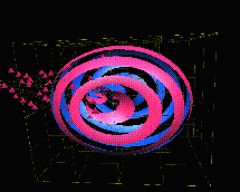Supercomputing ’93
November 1st, 1993
Categories: Applications, Data Mining, Human Factors, Networking, Supercomputing, Visualization

About
EVL’s exhibit at Supercomputing ’93 focused upon experiential science in the CAVE Virtual Reality Theater. Applications demonstrations included Astrophysics, Computational Fluid Dynamics, Math, Meteorology and Genetic Programming. Applications were run in one or two modes: locally on the SGI/CAVE and/or distributed between the CM-5 and the SGI/CAVE.
In local mode, CAVE participants explore pre-computed datasets. In distributed computing mode, participants may interactively steer their simulation codes on the CM-5. This ability enables CAVE users to explore and experiment with visualizations of pre-computed datasets, identify an area they want to enhance, and then invoke simulation codes on the networked supercomputer to compute new datasets. The CM-5 generates new data, which is then transferred to the SGI workstations for rendering and display in the CAVE.
Scientific simulation codes are typically large and complex, and require HPCC resources - massively parallel processors, vector processors, massive datastores, large memories, or high-speed networks - to run efficiently. Depending on the datasets and type of analysis the scientists want to do, they set up their simulation codes to calculate greater detail, a different time step, or a different state defined by new parameters. In some instances, codes can be executed locally but take longer to run, so supercomputers are used to provide faster interaction.
CAVE experiences enable researchers to interactively explore their scientific domains, play “what if” games by modifying their codes, and view the resulting visualizations in close-to-real-time. Virtual reality is recognized as an intelligent user interface to the emerging National Information Infrastructure, that will enable computational scientists and engineers to access HPCC enabling technologies and that will put the human in the loop for timely data analysis and understanding.